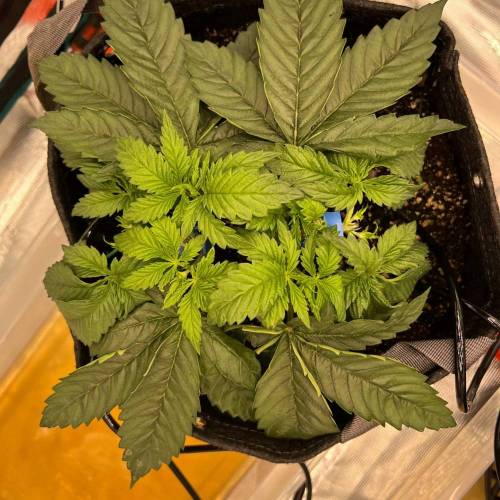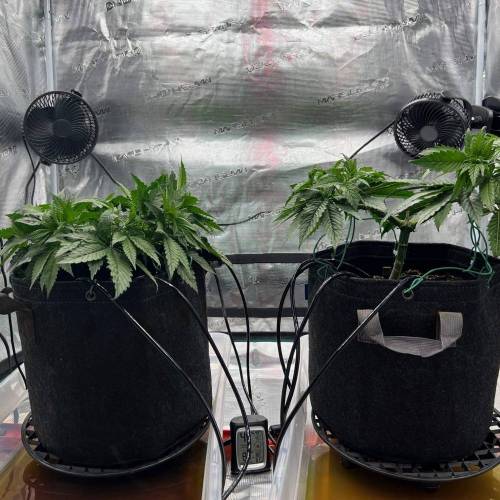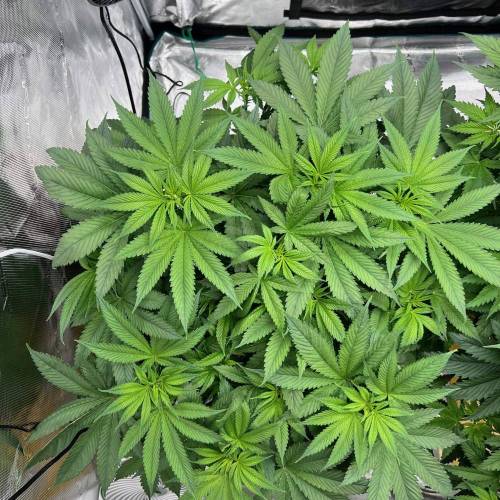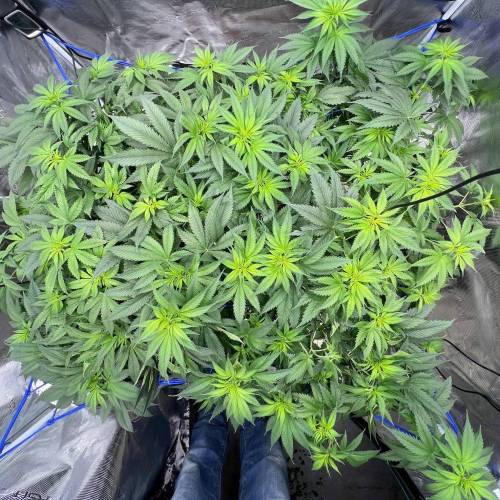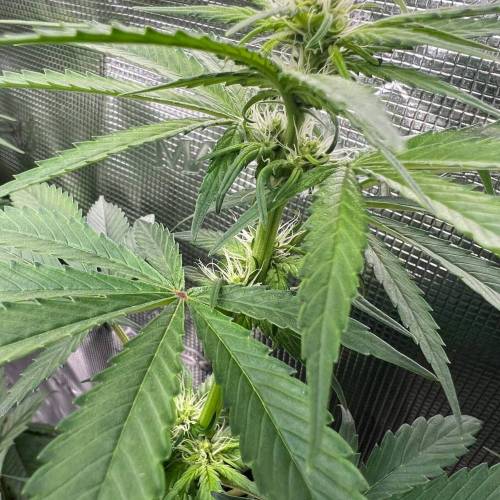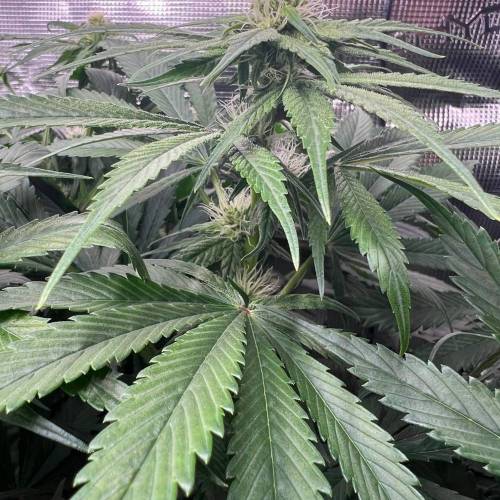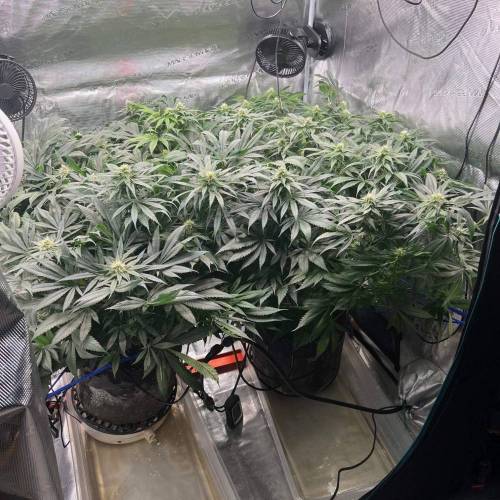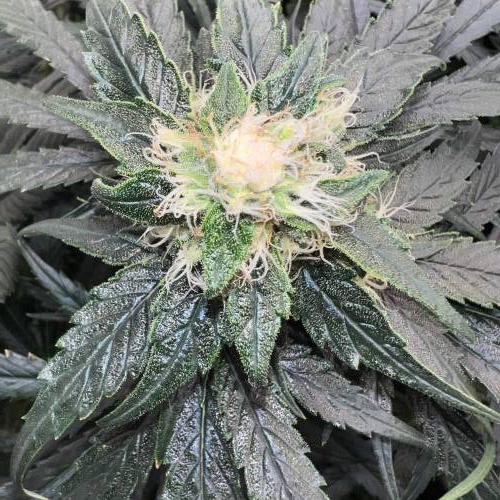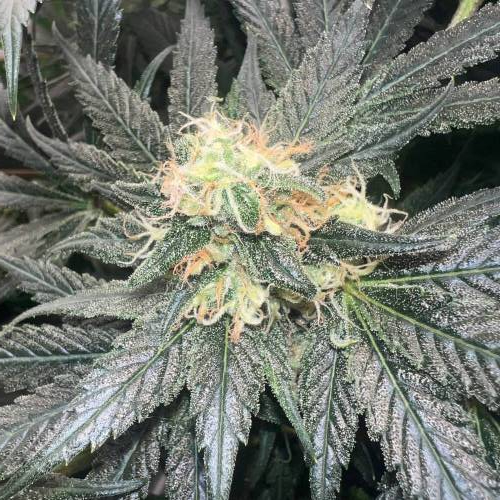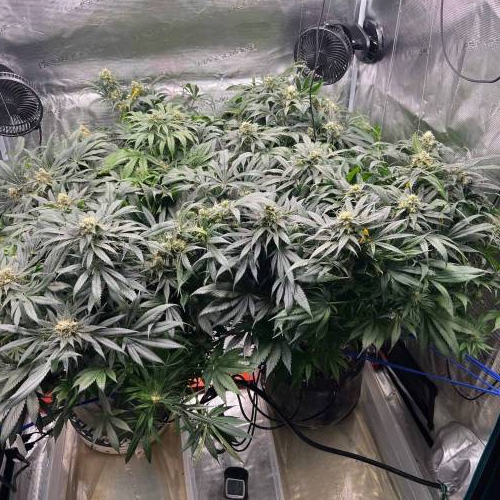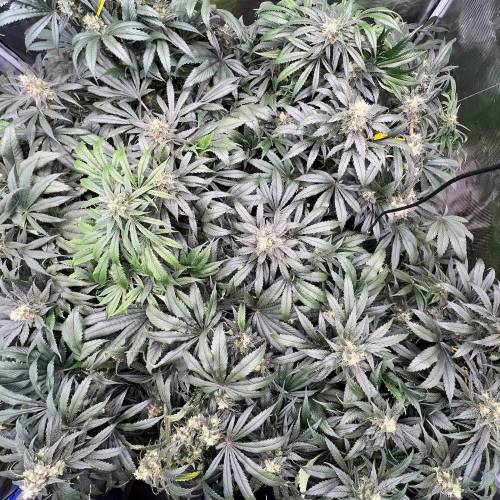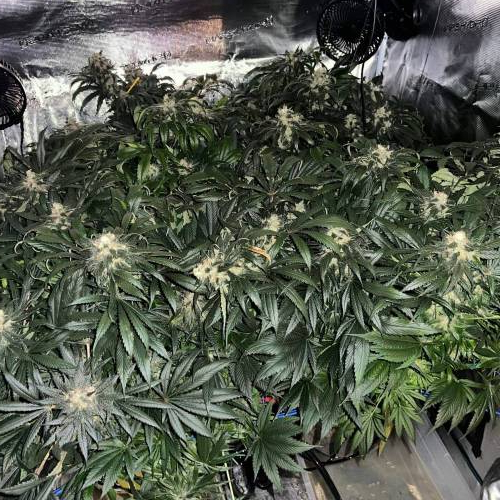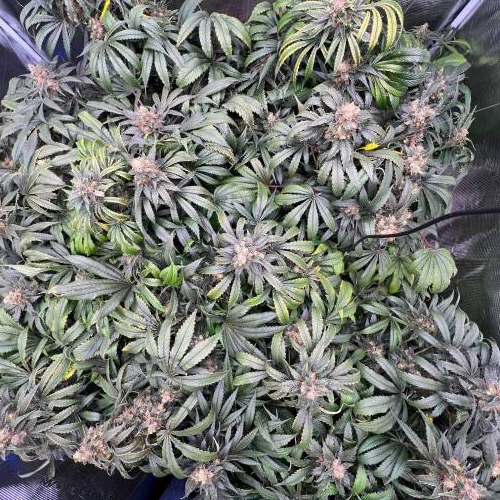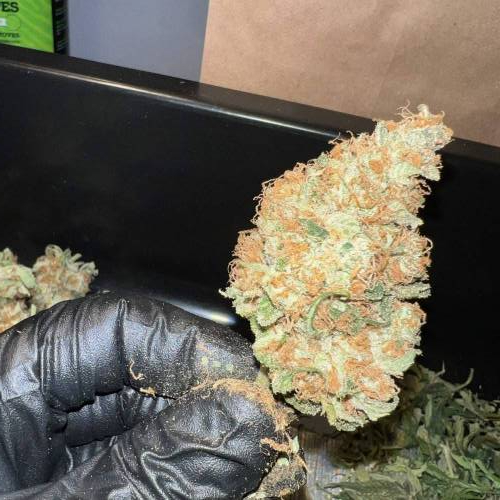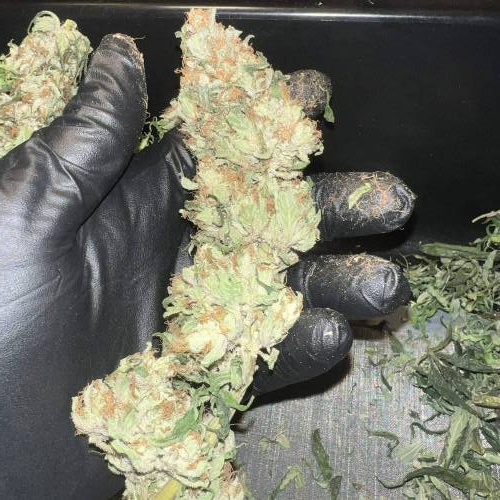The Grow Awards 2026 🏆 







P2 & P3 - ILGM Blue Dream 4x4 tent grow
Coco Coir
Custom
Aged Forest Products Other
Custom
Perlite
Custom
Basalt Other
Custom
Indoor
Room Type
Main-Lining
weeks 3-15
Topping
weeks 3-15
LST
weeks 3-15
Defoliation
weeks 3-15
HST
weeks 3-15
19 liters
Pot Size
Start at Harvest
G
Germination2y ago
DFWmd SEE MY OTHER DIARY FOR MORE DETAILS ABOUT THESE TWO PLANTS INCUDING SET-UP EQUIPMENT ETC - I started a grow with four seeds of which two germinated then a cat killed a seedling then I euthanized the remaining plant on its day 35. That was Plant 1. Plants 2 and 3 were started when plant 1 was 9 days old so I'm consolidating into this diary so the information matches the weeks, etc. I'll just be summarizing what's already in the other diary up until Veg Week 3 in this diary. That will be all new content.
BTW, the grow medium is Royal Gold Tupur, which is apparently some proprietary blend of coco coir (35-45%), aged forest products, perlite, and basalt. Since that's the order in the ingredients, I'm assuming the proportion of the total goes highest to lowest (that's how it is in the United States for ingredients listed on food labels. I guessed at the percentages when I set up the grow diary here.
GERMINATION
Day 1, August 30, 2023 - I plopped three Blue Dream seeds from ILGM into water until they sank. I then transferred to damp paper towels.
Day 3 - two of those three seeds popped. (So, (including attempts in my first diary) out of 7 seeds, 4 germinated. I contacted ILGM and they said to let them know within a year how many didn't germinated at they'd replace them.)
- Planted each in peat pellet and put in humidity dome.
Day 5 - moved seedlings into Solo cups and they received their first fertigation. (I'm basing a lot of this grow on info from CocoforCannabis.com, which advocates for providing nutrients with every watering, which is called fertigating.)
I'd made a 10x stock solution of Jack's Nutrients Clone by dissolving 31.55 grams of 15-6-17 into a gallon of distilled water.
---> I measured EC of tap water and it was 0.440. According to Jack's Nutrients nutrition schedule and their website, I'm to add the tap water EC with the target EC when making adjustments. For the Clone 15-6-17, the target EC is 1.1, so hope is mixed solution will measure at about 1.5 EC.
Per Coco for Cannabis website, mixed the following:
Step 1 - Filled a gallon container with tap water and took out 1.6 cups (10%, which is what I'll replace using the 10x stock solution of Clone 15-6-17.)
Step 2 - Added 1/2 tsp (2.5 mL) Armor Si silicon additive and waited at least an hour.
Step 3 - Added 1.6 cups of the 10x Clone stock solution.
Step 4 - Added 1/8 tsp of Humic Acid.
Step 5 - Added 1/64 tsp of Yucca.
Then, measure EC and adjust. Result was 1.3 so I left as-is.
Then, measure pH and adjust. Used color-changing solution for now and result was ~6.5-7; added pH Down and eventually result was ~5.5-6.
Step 6 - Added 1/4 tsp (1.25 mL) RapidStart.
Step 7 - Added 1/2 tsp (2.5 mL) H2O2.
Days 6 and 7 - working on first set of true leaves. The mix above was leftover from Plant 1 which at this point had moved on to the veg mix of nutrients. I made a new batch of propagation mix using above formula. The tap EC was 0.504 and the total was 1.344; the nutrient schedule states goal as 1.1 plus tap water EC, so that's less intense but I can increase that later by adding more of the clone 10x stock. I pH'd it to 6.0.
END OF 1ST WEEK FROM SEED
1 like
comments
Share
Used method
Paper Towel
Germination Method
1
Week 1. Vegetation2y ago
1.27 cm
Height
18 hrs
Light Schedule
27 °C
Day Air Temp
6.0
pH
No Smell
Smell
670 PPM
TDS
51 %
Air Humidity
23 °C
Night Air Temp
3.79 liters
Pot Size
Nutrients 7
Armor Si
0.651 mll
Epsom salt
0.234 mll
RapidStart
0.326 mll
DFWmd VEGETATION WEEK 1 (start of 2nd week from seed)
Days 8-12 - seems to be doing well. Fertigating by hand with propagation nutrient mix.
Day 13, Monday, Sept 11 - repotted from Solo cups into 1-gallon fabric pots
Set up and tested automatic fertigation via drip emitters. About 1 cup flowed through each emitter in 30 seconds.
I mixed up a 4-gallon batch of Veg nutrient solution:
In 58 cups of tap water that had 0.502 EC...
1. Armor Si (silica) - 10 mL
... waited at least 1 hour
2. Jack's Nutrients 15-5-20 tap + Epsom salt 10x solution - 6 cups <---edit (on Sept 17, I realized my stock solution was made with ~100 grams Epsom salt instead of ~10 grams!!!)
3. RAW Humic Acid - 1 tsp
4. RAW Yucca (wetting agent) - 1/8 tsp
... then, measure EC and adjust as needed to goal of ~2.596 EC total (target EC is 2.1 + background EC of tap water)... Measurement was 2.390 and I left as-is.
... then, measure pH and adjust as needed to goal of 5.8-6.2 and ended up with 5.9.
5. RapidStart - 5 mL
6. H202 - 10 mL
LED light is at 16 inches and 25% power.
Tuesday, Sept 12 (Day 14)
Trying to get drip emitters set up the way I want. Plants 2 and 3 each have 1 emitter. I started off with 20 sec per fertigation and increased to 30 sec per fertigation to ensure enough run-off. Fertigation timed to go every 6 hours initially (0600, 1200, 1800, 2400) then to every 5 hours with a break at night (0700, 1200, 1700, 2200.) I increased light intensity to 50%.
EC run-off of 2.412 reservoir was 2.174 for each of plants 2 and 3.
END OF 2ND WEEK FROM SEED
1 like
comments
Share
2
Week 2. Vegetation2y ago
2.54 cm
Height
18 hrs
Light Schedule
24 °C
Day Air Temp
5.9
pH
No Smell
Smell
1195 PPM
TDS
75 %
Air Humidity
21 °C
Solution Temp
23 °C
Night Air Temp
3.79 liters
Pot Size
40.64 cm
Lamp Distance
Nutrients 7
Armor Si
0.651 mll
Epsom salt
0.234 mll
RapidStart
0.326 mll
DFWmd Wednesday, Sept 13 (Day 15)
- Plants 2 and 3 - working on their 3rd nodes.
- EC of run-off of 2.758 reservoir was 2.258 for plant 2 and 2.488 for plant 3.
I increased fertigation frequency from 4x to 6x/day: 0400, 1200, 1600, 2000, 2400.
-----
Thursday, Sept 14 (Day 16)
EC of reservoir was 2.758 with Plants 2 and 3 both at 2.542.
I hand-watered using the remainder of the almost empty reservoir, soaked and cleaned using H2O2 and I made another 4-gallon batch using same amounts as the time previous:
In 58 cups of tap water...
1. Armor Si (silica) - 10 mL
... waited at least 1 hour
2. Jack's Nutrients 15-5-20 tap + Epsom salt 10x solution - 6 cups
3. RAW Humic Acid - 1 tsp
4. RAW Yucca (wetting agent) - 1/8 tsp
... then, measure EC and adjust as needed to goal of ~2.682 EC total (target EC is 2.1 + background EC of tap water was 0.582)... Measurement was 2.782 and I left as-is.
... then, measure pH and adjust as needed to goal of 5.8-6.2 and ended up with 5.7.
5. RapidStart - 5 mL
6. H202 - 10 mL.
I hope I don't have to go through 4 gallons of nutrient solution in 2-3 days! I reduced frequency from 6x to 5x/day: 0800, 1200, 1600, 2000, and 2400.
EC of reservoir that night was 3.030 and run-off of plant 2 was 2.932 and plant 3 was 3.026.
-----
Friday and Saturday (Days 17 and 18) - see pics above. I decreased light intensity back from 50% to 25% because of short plant 2.
-----
Sunday, Sept 17 (Day 19) - Reservoir ran out last night and I let it go without fertigation for about 20 hours until I got around to making up a new batch.
*** I realized when I made the new batch which included a new batch of stock solution that my previous stock solution had 10x the magnesium!!! *** (I read about it and fortunately shouldn't be devastating from what I could tell.)
New batch has correct Epsom salt amount. Otherwise, same as above.
EC of final batch was 2.550 with pH of 6.0.
I changed fertigation from 30 to 20 seconds and to 0900, 1200, 1500, 1800, 2100, and 2400.
-----
Monday, Sept 18 (Day 20) - this will be the first full week with the correct magnesium ratio in the nutrient solution (yesterday, I realized the 10x stock solution had 10x the magnesium it should have had!)
Plants 2 and 3 - Plant 3 seems to be doing very well! Plant 2 short with little distance between nodes. I'm hoping by the end of this calendar week they'll be transplanted into 5-gallon pots and maybe even topped for the first time.
-----
Tuesday, Sept 19 (Day 21) - went shopping at Walmart for some supplies, in particular stuff to utilize a bigger reservoir so I'm not mixing nutes every two days. CocoforCannabis website tutorials indicate ~5% of volume of grow container should be the amount of fertigation each time if fertigating 4-6x/day. For a 5-gallon pot, that's 4 cups! Once these two plants are in 5-gallon pots, that'll be 8 cups each feeding. If I fertigate 4x a day that's 2 gallons/day or 1 gallon per plant per day. If 5x/day then that's 2.5 gallons/day. For a week that's up to 17.5 gallons. So, I bought a 32-gallon plastic tote bin and I plan to make a week's worth at a time. I could put the pumps and tubes from the 5-gallon Mars Hydro bucket reservoir into that bigger reservoir, but I think I'll just refill the bucket from the bigger reservoir every day or two, which will help me adjust pH and EC more precisely and frequently. I'll make sure to clean everything weekly with H2O2.
While at Walmart I also got 1 gallon plastic containers that are pretty shallow to collect run-off. They were putting away gardening stuff and I got some heavy-duty plant stands on casters and will use that along with the drain tray and the plant lift (I sawed off the middle foot on each of those lifts and the outside feet fit perfectly around the middle platform of the drain tray.
I increased light intensity from 25% to 50% power.
END OF 3RD WEEK FROM SEED
2 likes
comments
Share
3
Week 3. Vegetation2y ago
7.62 cm
Height
18 hrs
Light Schedule
28 °C
Day Air Temp
6.0
pH
Weak
Smell
1210 PPM
TDS
66 %
Air Humidity
22 °C
Solution Temp
26 °C
Night Air Temp
18.93 liters
Pot Size
3.79 liters
Watering Volume
40.64 cm
Lamp Distance
Nutrients 7
Armor Si
0.651 mll
Epsom salt
0.234 mll
RapidStart
0.326 mll
DFWmd Wednesday, Sept 20 (Day 22) - Calculations for 20 gallons of veg nutrient solution (I was going to do 28 gallons but my container looked too weak, the sides bowing out, so this time I just did 20 gallons):
In 20 gallons of tap water...
1, Add 50 mL Armor Si (silica) and wait 1+ hours.
2. Add Jack's Nutrients 15-5-20, 100.94 grams, and Epsom salt, 19.79 grams. (Nutrient schedule says 504.72 grams 15-5-20 and 98.94 grams Epsom salt pr 100 gallons.)
3. Add 5 tsp RAW humic acid
4. Add 5/8 tsp RAW Yucca (wetting agent)
... measure EC and adjust if needed. Tap water was _0.462_ and goal for total is 2.1 + tap, or __2.562__. Ended up with _2.416_.
... measure pH and adjust to goal of 5.8-6.2. Ended up with __6.0__.
5. Add 25 mL RapidStart.
6. Add 50 mL H2O2.
-----
Thursday, Sept 21 (Day 23) - (Focused on Plant 1 which I eventually decided to abandon.)
-----
Friday, Sept 22 (Day 24) - Late at night I transplanted plants 2 and 3 into 5-gallon pots.
-----
Saturday, Sept 23 (Day 25) - I hand-watered each pot to ensure saturation then arranged it so each has two drip emitters. I changed the duration of each timed fertigation from 20 to 30 sec then 40 seconds. I estimate each fertigation should be ~3 cups nutrient solution which at 6x/day would be 18 cups or 1 1/8 gallons.
For a few different reasons (see first diary for this grow for more explanation), I decreased the EC. The nutrient schedule for Jack's Nutrients suggested no need to work your way up slowly but it clearly would've been safer for me to do that. Their feeding chart shows that for vegetative growth, the EC should be 2.1 plus the tap water (for 15-5-20.) Tonight, I reduced by 5-gallon reservoir nutrient solution EC from 2.566 to 2.048, ~20% lower. I pH'd to 5.9.
*[Note: Plants 2 and 3 had five days of nutrient solution (Days 14-18) that had 10x the magnesium.]
I topped plant 3 tonight.
-----
Sunday, Sept 24 (Day 26) - (I gave up on Plant 1 and pitched it. That had been the impetus for the first diary. After today, content will be new. Up until now it's been mostly summarized from that first diary, edited to focus on just Plants 2 and 3.)
At this point with Plant 1 gone it's just Plants 2 and 3. I adjusted the Mars Hydro drip emitters so each plant has 4 emitters. Each fertigation is set for 20 seconds which should be about 2/3 cup per emitter or 2 2/3 cup per plant per fertigation. At 6x/day, that's about 1 gallon per plant. When the plants are flowering, I'll likely increase the fertigation duration to 30 sec which would be 4 cups per fertigation total, and, at 6x/day, 1.5 gallons per plant. 4 cups is 5% of the volume of a 5-gallon pot.
I topped Plant 2 and trimmed all leaves below that 3rd node.
I've decided Plant 2 will be Manifolded as credited to Nebula Haze, which from my reading is topping twice, accomplishing eight branches by topping and training after the first topping so each side after the first topping ends up with four branches.
I've decided Plant 3 will be Mainlined as credited to Nugbuckets, which from my reading is topping three times at symmetrical nodes to produce eight equal main branches.
(I know some of these terms are interchangeable/overlap, but this is how I'm thinking about them.)
-----
Monday, Sept 25 (Day 27) - Plant 2 is recovering from the topping/trimming that it went through yesterday. Plant 3 seems to be doing well. I supercropped and tied down the branches growing from that first topping to help them grow out from the center more. (My first time that I am sure I did it correctly. I felt the pop in the branch when I squeezed it and the result looks just like lots of pictures in tutorials I've ready. Yay!)
EC of the 5-gallon reservoir today was ~2.05; I pH'd to 5.8. I checked the run-off from yesterday's fertigation and the results were lower than the reservoir EC.
-----
Tuesday, Sept 26 (Day 28) - supercropped Plant 2but didn't tie down. I'm continuing to try to train Plant 3. Refilled 5-gallon nutrient reservoir: pH'd to 6.0 and EC ~2.0. Run-off was low at first, I thought, but I think I forgot to switch mode to EC from PPM. When I was more careful, the run-off seemed ~0.4-0.5 higher. I'll increase duration of fertigation from 20 to 25 seconds. Eventually, it'll go to 30 seconds and that may be needed now but I'm also trying not to waste nutrient solution.
-----
END OF 4TH WEEK FROM SEED
1 like
comments
Share
Used techniques
LST
Technique
HST
Technique
Topping
Technique
Main-Lining
Technique
Defoliation
Technique
4
Week 4. Vegetation2y ago
15.24 cm
Height
18 hrs
Light Schedule
28 °C
Day Air Temp
6.0
pH
Weak
Smell
995 PPM
TDS
63 %
Air Humidity
22 °C
Solution Temp
26 °C
Night Air Temp
18.93 liters
Pot Size
3.79 liters
Watering Volume
40.64 cm
Lamp Distance
Nutrients 7
Armor Si
0.651 mll
Epsom salt
0.234 mll
RapidStart
0.326 mll
DFWmd Wednesday, Sept 27 (Day 29) - Run-off EC still high by ~0.3-0.5, after increasing duration of fertigation from 20 to 25 seconds. Tomorrow morning, I'll increase it to 30 seconds.
Plant 2 - This is the manifold (Nebula Haze) technique. It looks good but is behind growth-wise, compared to plant 3. (4 inches tall vs 7.5 inches tall.) First topping was when 5 nodes grown, after the 3rd node. Each of those are now working on their second nodes from that topping. After each side has 4 nodes, I'll top after the 3rd node and trim the second node, keeping the 1st node. Colas should then develop from the topping after the 3rd node and from the growth tips on the 1st node. Training those two halves should allow four colas to establish on each, 8 total.
Plant 3 - This is the mainline (Nugbuckets) technique. First topping was when 5 nodes grown, after the 3rd node. Each of those sides have decently-established 2nd nodes and are just getting hints of 3rd nodes. Once past the 3rd node, I'll top each half to that and then when the two on each half get past their 1st node then I'll top again. That should get to 8 colas via main stem split to two and each of those split then each of those split. 2^3 = 8 total. I've kept most lower fan leaves but have trimmed the growth tips.
Lighting still at 50% power.
-----
Thursday, Sept 28 (Day 30) - I'd taken off plant ties to be more conservative with training but tonight I went back at it. Unfortunately, I squeezed too hard on Plant 3 and tore the stem skin (in a twisty-way, not at the junction) when I supercropped. I wrapped with horticultural tape and hopefully it'll be okay... 😕
At ~1800, I refilled the 5-gallon bucket reservoir from the 20-gallon tote supply and added tap water. EC went from ~2.5 to ~2.0. pH'd to 5.8. I checked run-off and much improved with results only +0.1 to +0.2. 😁
-----
Friday, Sept 29 (Day 31) - Plant 2 is working on 3rd node. The injured part of Plant 3 seems to be recovering with little problem. Just getting past the 3rd node.
-----
Saturday, Sept 30 (Day 32) - I'll probably top Plant 2 tomorrow, above the 3rd node, which is just finishing up today. I topped Plant 3 above the 3rd node. I'll trim each plant appropriately but want to double-check before actually cutting.
From what I've learned via websites and videos:
Plant 2 (Nebula Haze-style) - Trim each split from the first topping above their 3rd nodes then cut growth tips (and fan leaves) from the 2nd node on each branch. Ensure all growth nodes besides the 3rd and 1st nodes on each branch are trimmed. Maybe trim most of the fan leaves, or at least ones that are shaded by leaves above?
Plant 3 (Nugbuckets-style) - Trim all growth tips other than from that 3rd node which I just topped to. Each of those, branched off the first topping, should grow into main stems, two on each side. After the first node on each of those four is well-established, I'm to top for the last time. Each of those four should grow two main stems, from which the eight colas will develop. Same thing regarding fan leaves: at least the ones shaded if not all the ones below the topping?
Filled the 5-gallon reservoir with the rest of the 20 gallons of nutrient solution I'd made last week in the big tote, adjusted so EC was 3.024 and pH'd to 6.0. Cleaning out the big tote today and will clean/soak the 5-gallon bucket and pump and heater etc when it empties, presumably tomorrow morning.
-----
Sunday, Oct 1 (Day 33) - I trimmed just about all foliage below the latest toppings. I then supercropped and bent branches to train canopy. I'm worried I was inadvertently too rough on them... If the skin of the stem split I taped with horticultural tape. (Clearly, I need to be training before the branches get too thick.
Plant 2, being manifolded (Nebula Haze-style), keeping nodes 1 and 3 after topping above the 3rd node, I used LST clips.
Plant 3, being mainlined (Nugbuckets-style), I used soft plant ties. I'd topped after the 3rd node on each side and there should be four main stems developing. I'll top each of those after their 1st nodes are well-established.
I'm making up a new big batch of nutrient solution in the 32-gallon tote. I'd gotten a second tote and nested the first one in it to strengthen the walls. (The sides had started bowing out after filling with 24 gallons of water.) Today, I'm making 24 gallons instead of 20:
1. 24 gallons tap water (EC 0.464)
2. 60 mL Armor Si (then wait at least an hour)
3. 121 grams Jack's Nutrients 15-5-20 and 24 grams Epsom salt
4. 6 teaspoons humic acid
5. 3/4 teaspoon Yucca
..... Check and adjust EC to goal of 2.1 + tap = 2.564. Actual result: _2.392_
..... Adjust pH to 5.8-6.2. Actual result: _5.9_
6. 30 mL RapidStart
7. 60 mL H2O2
-----
Monday, Oct 2 (Day 34) - I made the batch this morning, after cleaning the pumps and reservoir containers with H2O2. Details above. Plants are recovering from yesterday's topping and trimming and training.
-----
Tuesday, Oct 3 (Day 35) - Pretty much the same as the day before. Refilled 5-gallon reservoir from the big tote and pH was 6.1; I left as-is.
-----
END OF 5TH WEEK FROM SEED
2 likes
comments
Share
Used techniques
LST
Technique
HST
Technique
Topping
Technique
Main-Lining
Technique
Defoliation
Technique
Grow Questions
DFWmdstarted grow question 2y ago
Finishing up the topping portion of mainlining. P2 to be Nebula-Haze style and P3 to be Nugbuckets style. I'll be trimming growth tips other than from the 8 cola sites on each. Still keep un-shaded fan leaves below those levels? A lot online shows all lower fan leaves trimmed
Solved
Techniques. Topping
Techniques. Main-lining
Techniques. Defoliation
likes
thedoeanswered grow question 2y ago
if the 8 growth shoots are ready to ride solo, you could remove the leaves if you cant tuck them.
by that I mean they are developed and are already working on their 2nd node or so, if theyre too small it makes no sense.
check out my grow; I had the same idea for 8 tops! same guide
mine is probably not as bushy but youll get the idea.
especially if youre not limited on time then it will recover regardless.
just faster if they are ready to grow without need of those big fanleaves.
5
Week 5. Vegetation2y ago
15.24 cm
Height
18 hrs
Light Schedule
28 °C
Day Air Temp
6.1
pH
Weak
Smell
1170 PPM
TDS
63 %
Air Humidity
22 °C
Solution Temp
26 °C
Night Air Temp
18.93 liters
Pot Size
3.79 liters
Watering Volume
40.64 cm
Lamp Distance
Nutrients 7
Armor Si
0.651 mll
Epsom salt
0.234 mll
RapidStart
0.326 mll
DFWmd Wednesday, Oct 4 (Day 36) - I'm guessing 1-2 weeks until I'll flip to 12/12....
Plant 2 - looking really good! Lots of fan leaves. In a day or two I'll do some trimming and start training the 8 final branches/cola sites.
Plant 3 - I trimmed the big fan leaves so it looks really scraggly at the moment. I supercropped the four branches this morning and this afternoon I tied them down as part of training. They're each working on their 2nd node. When more established I'll top below it - which will be the final topping, getting to the 8 final branches/cola sites.
-----
Thursday, Oct 5 (Day 37) - Trimmed plant 2. Topped plant 3 for the final time.
-----
Friday, Oct 6 (Day 38) - out of town (left in morning)
-----
Saturday, Oct 7 (Day 39) - out of town (returned in evening)
-----
Sunday, Oct 8 (Day 40) - gave plants extra watering. I guess at this point that I just let them veg a while (kind of a pun there, right?) Not sure how much training/trimming to do over the next week or two before I flip to 12/12 to induce flowering. I noticed a couple of sites seem to only have one new branch instead of two new branches above the topped node. Maybe I injured one of the growth tips? Should I have waited longer before topping?
I'm already looking forward to my next grow, now that I've gotten more comfortable growing again.
-----
Monday, Oct 9 (Day 41) - continuing to veg and train. (No pics for today.)
-----
Tuesday, Oct 10 (Day 42) - continuing to veg and train. Both plants clearly have 8 main sites and my hope is they'll develop some more this next week, then I'll flip to 12/12.
-----
END OF 6TH WEEK FROM SEED
2 likes
1 comment
Share
Used techniques
LST
Technique
HST
Technique
Topping
Technique
Main-Lining
Technique
Defoliation
Technique
6
Week 6. Vegetation2y ago
22.86 cm
Height
18 hrs
Light Schedule
28 °C
Day Air Temp
6.0
pH
Weak
Smell
1320 PPM
TDS
45 %
Air Humidity
22 °C
Solution Temp
26 °C
Night Air Temp
18.93 liters
Pot Size
3.79 liters
Watering Volume
40.64 cm
Lamp Distance
Nutrients 7
Armor Si
0.651 mll
Epsom salt
0.469 mll
General Hydroponics - Diamond Nectar
1.302 mll
DFWmd Wednesday, Oct 11 (Day 43) - I think this will be my final week of vegetative growth. Continuing to train via supercropping and LST. Jack's Nutrients has a Bloom 10-30-20 to use with Epsom salt for the first week of flower.
This, then, may be my final batch of veg nutrient solution. (Although, most of flower is the same stuff according to Jack's Nutrients schedule.) I made another 24-gallon batch in my nested 32-gallon tote:
1. 24 gallons tap water (EC 0.420)
2. 60 mL Armor Si (then wait at least an hour)
3. 121 grams Jack's Nutrients 15-5-20 and 24 grams Epsom salt (I ended up needing about double this to get the target EC...)
4. 120 mL General Hydroponics Diamond Nectar (Used up my supply of RAW humic acid.)
5. 3/4 teaspoon Yucca
..... Check and adjust EC to goal of 2.1 + tap = 2.520. Actual result: _2.636_
..... Adjust pH to 5.8-6.2. Actual result: _6.0_
6. 30 mL RapidStart (I'm almost out of this stuff; should I get more? It's pretty expensive...)
7. 60 mL H2O2
Grow light power has been 100% the last couple of days; today, I made sure it was 16 inches from the canopy.
My original plan was to grow four Blue Dream plants and I think a 4x4 tent would clearly support that.
-----
Thursday, Oct 12 (Day 44) - trying to keep an even canopy with mostly LST.
-----
Friday, Oct 13 (Day 45) - they look good to me.
I'm unsure about trimming at this point: What's the goal for just before switching to 12/12? I've read to veg until your height is 1/2 to 1/3 the final height supported by the setup.
-----
Saturday, Oct 14 (Day 46) - I'm going to make the above question a grow question to get some advice...
-----
Sunday, Oct 15 (Day 47) - Thanks to all who answered my grow question!
-----
Monday, Oct 16 (Day 48) - I'm still just kind of letting the last bit of vegetative growth happen. I'm pretty happy with how they're looking!
-----
Tuesday, Oct 17 (Day 49) - Not much volume of run-off anymore, likely because of how much the plants have grown. I increased the duration of each fertigation from 25 to 30 seconds (20% more.) I have a trellis and was thinking of using it, maybe for ScrOG or at least just for extra bud support. After reading again information about ScrOG, seems that may have made more sense earlier on, along with less manifold/mainline-based topping. I read NebulaHaze's defolation tutorial from her website (growweedeasy.com) and will be utilizing that guidance:
Immediately before switch to 12/12, I will completely strip the leaves (leaving bud sites) from the lower part of each plant that is currently in shade, as well as removing bigger (but not all) fan leaves from the canopy, to the point that stems are easily seen, making sure not to damage bud sites. She recommends a second defoliation two weeks later, then mainly tucking big fan leaves to keep bud sites exposed.
So, I'm planning on doing that tomorrow morning. I'll also use the remaining veg nutrient solution as a kind of salt flush, hand-fertigating the two plants whatever is left in the 5-gallon reservoir and the big tub reservoir. I'll clean the reservoirs and pumps, etc. and make up the Bud Set fertigation solution for this first week of flowering. I'll defoliate as described and change the light schedule to 12/12 (likely 1930-0730.)
I'm excited!
-----
END OF 7TH WEEK FROM SEED
1 like
1 comment
Share
Used techniques
LST
Technique
HST
Technique
Topping
Technique
Main-Lining
Technique
Defoliation
Technique
Grow Questions
DFWmdstarted grow question 2y ago
I'm unsure about trimming/defoliation at this point: What's the goal for just before switching to 12/12? I've read to veg until your height is 1/2 to 1/3 the final height supported by the setup. I seem to have plenty of room still. How much do I trim under the canopy?
Solved
Techniques. Defoliation
3 likes
mcflowanswered grow question 2y ago
if you're just before the switch to the flowering stage (12/12), focus on the following specifics:
Undercanopy Trimming:
Trim the lower branches and leaves that won't receive much light in the flowering stage. This directs energy to the top canopy.
Remove Large Fan Leaves:
Take out any large fan leaves that are shading potential bud sites in the lower and inner parts of the plant.
Maintain Airflow:
Ensure good airflow by removing excess foliage in the undercanopy. This helps prevent humidity-related issues.
Avoid Over-Pruning:
Be cautious not to over-prune, as you still want the plant to have enough foliage for photosynthesis and energy production.
Top Canopy Focus:
Concentrate on opening up the top canopy to allow light penetration and airflow for the main bud sites.
Remember, the idea is to strike a balance between removing excess foliage and maintaining enough leaves for the plant's overall health. Keep an eye on how the plant responds and adjust accordingly.
7
Week 7. Flowering2y ago
33.02 cm
Height
12 hrs
Light Schedule
25 °C
Day Air Temp
6.0
pH
Weak
Smell
1160 PPM
TDS
66 %
Air Humidity
19 °C
Solution Temp
19 °C
Night Air Temp
18.93 liters
Pot Size
3.79 liters
Watering Volume
40.64 cm
Lamp Distance
Nutrients 7
Armor Si
0.651 mll
Epsom salt
0.43 mll
General Hydroponics - Diamond Nectar
1.302 mll
DFWmd Wednesday, Oct 18 (Day 50) - FIRST DAY OF FLOWER!
I did a whole lot of defoliation to both plants. I used LST clips on Plant 3 to try to lower the canopy a bit to better match Plant 2. I've also angled the light a bit so it's 16 inches above both plants. After defoliating, Plant 3 looks much stronger than Plant 2.
I used the remaining of my veg nutrient solution to flood-fertigate each plant at about 1200, probably 2-3 gallons to each plant.
I scrubbed and soaked pumps and water heater, etc., with H2O2. Cleaned big tub reservoir.
In the big tub reservoir, I made 24 gallons of 'Bud Set' nutrient solution as detailed in Jack's Nutrients nutrition schedule for this first week of flower. I'm using the 10-30-20 Bloom then after about a week I'll switch back to 15-5-20. (The nutrition schedule says to continue with 15-5-20 until about the last week of flower, when 7-15-30 Finish is used. then 4-7 day flush with clear water then harvest.) This will be my last batch with RapidStart, too. I only had 15 mL left; it's expensive!
1. 24 gallons tap water (EC 0.420)
2. 60 mL Armor Si (then wait at least an hour)
3. 136 grams Jack's Nutrients 10-30-20 and 24 grams Epsom salt (I ended up needing about double this to get the target EC...)
4. 120 mL General Hydroponics Diamond Nectar.
5. 3/4 teaspoon Yucca
..... Check and adjust EC to goal of 1.9 + tap = 2.320. Actual result: ~2.8 in the reservoir so I'll ensure to dilute with tap water every time I refill the 5-gallon reservoir until it's ~2.32
..... Adjust pH to 5.8-6.2. Actual result: _6.0_
6. 15 mL RapidStart (All gone!)
7. 60 mL H2O2
I changed my light timer from 18/6 (off from 0100-0700) to 12/12 (off from 1900-0700.)
-----
Thursday, Oct 19 (Day 51) - the plants seem to be recovering from the defoliation. I'm trying to LST the canopy to keep it as flat as possible.
-----
Friday, Oct 20 (Day 52) - I've been LST-clipping Plant 3 to try to even out the canopy with Plant 2, with some success, but Plant 3 just seems so much more vigorous that I decided to raise up Plant 2 using drain trays I hadn't been using. The canopy is now even! I noticed Plant 3 had some new leaves with yellow edges/tips. I asked a grow question about it and seems to be light burn (appreciate the feedback as always!) I'll raise the light a bit in the morning, when out of the dark period.
-----
Saturday, Oct 21 (Day 53) - out of town but made sure nutrient reservoir was full before I left.
-----
Sunday, Oct 22 (Day 54) - they seem to be doing well from what I can tell. Moving the lights farther away seems to have stopped the light-burn/yellow tips.
-----
Monday, Oct 23 (Day 55) - I'm eager to see and smell flower development but nothing so far...
-----
Tuesday, Oct 24 (Day 56) - Just a day.
-----
END OF 8TH WEEK FROM SEED
likes
comments
Share
Used techniques
LST
Technique
HST
Technique
Topping
Technique
Main-Lining
Technique
Defoliation
Technique
8
Week 8. Flowering2y ago
33.02 cm
Height
12 hrs
Light Schedule
30 °C
Day Air Temp
5.9
pH
Weak
Smell
1210 PPM
TDS
67 %
Air Humidity
22 °C
Solution Temp
21 °C
Night Air Temp
18.93 liters
Pot Size
3.79 liters
Watering Volume
60.96 cm
Lamp Distance
Nutrients 6
Armor Si
0.651 mll
Epsom salt
0.339 mll
General Hydroponics - Diamond Nectar
1.302 mll
DFWmd Wednesday, Oct 25 (Day 57) - finishing up the first week of 12/12. I've been using a Bloom nutrient solution and the last couple of days there have been some discoloration-- first, slight yellowing of the edges of the leaves up toward the light of Plant 3. I raised the lights, decreased the power some, then increased the power but kept it farther away. Today, I noticed a few leaves have some yellow mottling, too. (I've asked a second grow question just now for feedback, but based on the first grow question's answers, it's likely related to the Bloom nutrient solution, which I'll be switching back tomorrow to the main Flower nutrient solution (which is the same as the Vegetative nutrient solution). Hopefully, everything will settle down within the next few days. I'll update details in tomorrow's comments and also update the Nutrients, above, with the details of the new nutrient batch.
Grow Techniques-wise, I've Mainlined/Manifolded which involves topping and LST and HST (via supercropping) and defoliated, but this week I'm basically just letting growth continue. My plan is to trim the bottom 3rd of the plant at the end of week 3 of flower. I keep reading mixed messages regarding defoliating during flower-- some say keep all the leaves because they're what power the plant via light and will therefore allow more flower growth... and some say it's best to get rid of at least the biggest fan leaves because the light needs to reach the bud sites (?) I understand the need to ensure good air flow to prevent mold. Feel free to add your thoughts about it but please include your reasoning.
-----
Thursday, Oct 26 (Day 58) - Dumped the remaining Bloom fertigation solution and made up a new batch. The Bloom was there the first week only of 12/12, as recommended by Jack's Nutrients. Now, back to the same combination from vegetative growth using 15-5-20:
1. 24 gallons tap water (EC 0.418)
2. 60 mL Armor Si (then wait at least an hour)
3. 121 grams Jack's Nutrients 15-5-20 and 24 grams Epsom salt (I ended up needing 182 grams and 36 grams to get close enough to the target EC...)
4. 120 mL General Hydroponics Diamond Nectar.
5. 3/4 teaspoon Yucca
..... Check and adjust EC to goal of 2.1 + tap = 2.518. Actual result: _2.416_
..... Adjust pH to 5.8-6.2. Actual result: _5.9_
6. 60 mL H2O2
I put up a trellis today to help with supporting buds and evening out the canopy. Ended up kind of accidentally supercropping a few spots....
And also: first clear pistils noticed!
And also, also, see two most recent Grow Questions for information about what I hope has been mild S deficiency; pics above, too.
-----
Friday, Oct 27 (Day 59) - Plants seem good overall. I'm not sure if setting up the trellis has more pros than cons. Pros would be more support for colas and maybe broader, flatter canopy and maybe easier to decide on what to trim/lollipop. Cons would be if the trauma and LST and accidental supercropping involved with getting the trellis in place, etc, ends up delaying some growth/development of the plants.
I'm probably going to buy a small dehumidifier for the grow tent. First step is to be more diligent about vacuuming out the run-off from the fertigation. But I still think humidity will be no lower than 50-60% without a dehumidifier. I'm looking online and have it narrowed down to a few options, ranging from $45-80. Anyone have any recommendations?
-----
Saturday, Oct 28 (Day 60) - pretty unremarkable day.
-----
Sunday, Oct 29 (Day 61) - more remarkable of a day: cat chewed on line from bucket reservoir into tent and it leaked during fertigation at least at 0900 this morning, maybe at 2400 the night before. Not a ton of nutrient solution was lost. I was able to trim off that section and shift the valve which also pushed the bucket reservoir right up against the tent. Hopefully, no more chewing at this point. Then... I noticed after the 1800 fertigation that the bucket reservoir was empty even though I'd just filled it that morning. My guess is losing that slack in the line changed it so a siphon was created. I filled the bucket again and poked a hole at the top of the line on the inside of the bucket to prevent a siphon hopefully. We'll see....
Also, I sprinkled a little extra Epsom salt in my big tote reservoir in case it might help with any sulfur deficiency. Still just a bit of yellow mottling on a few of the newer leaves. I'm verifying pH is how it should be. The siphon I discussed above was effectively a flushing.
-----
Monday, Oct 30 (Day 62) - I figured out that it wasn't siphoning going on. Somehow, I'd messed up the timer, seemingly copying the 5 minute mixing pump schedule to the fertigation pump outlet. So, instead of 30 seconds it was running 5 minutes. For a couple of hours, I also had messed up the AC Infinity fan controller settings, so it really hot in the tent. I fixed both issues. The fan controller I set so it'd keep the temp and humidity lower and that's working, so I no longer think I need a dehumidifier. That's good news, at least!
I made another batch of fertigation solution:
1. 24 gallons tap water (EC 0.426)
2. 60 mL Armor Si (then wait at least an hour)
3. 121 grams Jack's Nutrients 15-5-20 and 24 grams Epsom salt (I ended up needing 182 grams and 36 grams to get close enough to the target EC...)
4. 120 mL General Hydroponics Diamond Nectar.
5. 3/4 teaspoon Yucca
..... Check and adjust EC to goal of 2.1 + tap = 2.518. Actual result: _2.516_
..... Adjust pH to 5.8-6.2. Actual result: _5.9_
6. 60 mL H2O2
A few leaves have nine fingers; see pic above of a nice example.
-----
Tuesday, Oct 31 (Day 63) - Happy Halloween! Today, everything seems to be working fine. I tucked a couple of the taller branches to try to keep canopy even. More pistils noticeable.
-----
END OF 9TH WEEK FROM SEED
likes
comments
Share
Used techniques
LST
Technique
HST
Technique
Topping
Technique
Main-Lining
Technique
Defoliation
Technique
9
Week 9. Flowering2y ago
55.88 cm
Height
12 hrs
Light Schedule
22 °C
Day Air Temp
5.8
pH
Weak
Smell
1265 PPM
TDS
55 %
Air Humidity
22 °C
Solution Temp
20 °C
Night Air Temp
18.93 liters
Pot Size
4.43 liters
Watering Volume
40.64 cm
Lamp Distance
Nutrients 6
Armor Si
0.651 mll
Epsom salt
0.339 mll
General Hydroponics - Diamond Nectar
1.302 mll
DFWmd Wednesday, November 1, 2023 (Day 64) - finishing up the second week and starting the third week of 12/12. Some pistils are noticeable on just about every main branch. My plan is to trim again at the end of this week, lollipop most of what's under the trellis and try to keep most of the plant above the trellis, tucking fan leaves when needed. I'll trim enough fan leaves to make sure there is good airflow and light penetration. (I saw some examples of people trimming just about all the fan leaves, including videos from professional grow operations. So, I'm definitely not 100% sure I shouldn't be doing similarly. Maybe next Wednesday, I'll do the less trimming plan and take pics and ask a Grow Question to get feedback and reasoning. It just makes sense that you'd want to keep fan leaves as they are what power the plant, including flowering, right?)
I checked the run-off EC and it was about 1.0 more than the fertigation solution EC?! I increased fertigation timing from 30 to 40 seconds. The mixing pump goes for the first 5 minutes then the fertigation pump goes. Times are 0400, 0900, 1200, 1500, 1800, 2100, and 2400. Tomorrow, I'll check run-off again with fresh run-off. Today, it was run-off building up from a few fertigations (I only vacuum out the liquid when it gets close to the bottom of the fabric pots.)
-----
Thursday, November 2, 2023 (Day 65) - The run-off today for Plant 2 was about 0.8 and for Plant 3 still about 1.0. I'll keep monitoring and ensure it continues to trend down; if needed I could increase the duration to greater than 40 seconds, but then a full 5-gallon bucket would not be enough for 24 hours of fertigation.
I'm going to ask a grow question about whether I should continue keeping the canopy as flat as possible or to just let the colas go (as long as not too close to the light.)
-----
Friday, November 3, 2023 (Day 66) - I went ahead and lollipped, even though it's only been 16 days post-12/12 flip. A lot of guidelines recommend 21 days after flip. From now until harvest, I plan to defoliate only sparingly. Training (manifolding/mainlining) essentially done. I was trying to compare the Nugbuckets method with Nebula Haze's method but two different phenotypes so not a great experiment. Using clones would be the best comparison, limiting variables. Regardless, I think either method led to good results, because the canopy from two plants pretty much fills the 4x4 tent.
I checked EC run-off again and still was +1. Maybe some of that is from evaporation because I haven't been checking only the one fertigation run-off right away? I also don't seem to be getting much volume from my run-off, despite increasing the fertigation duration from 30 to 40 seconds. The hole I put in the tubing to prevent siphoning maybe plays a role with less volume but I doubt it. I could re-measure... I could just keep increasing the duration, but I don't want to waste nutrients too much and also don't want to have to fill the 5-gallon reservoir more than once in 24 hours. I will, though, if needed. Since my plants are looking good, I may just not even worry about it and quit measuring run-off! Prioritize how the plant looks overall over a (hopefully) isolated detail being off.
I appreciate everyone who has been answering grow questions and/or commenting on the diary. Keep it up!
-----
Saturday, November 4, 2023 (Day 67, 17 days into flower) - There's about 8 gallons of nutrient solution in the big tub. I pH'd to 5.8 and checked EC was ~2.8. There likely wasn't anything in the 5-gallon bucket reservoir for the 1200 fertigation, so I put about 6 cups in each pot by hand. Still considering increasing fertigation duration beyond 40 seconds...
Flower develop quite noticeable and looking good! I'm pleased and excited!
-----
Sunday, November 5, 2023 (Day 68, 18 days into flower) - Stretching continues. Plants seem good to me. I need to clean the 5-gallon bucket tomorrow; some scummy stuff or residue...
Made another big batch of nutrient solution:
1. 24 gallons tap water (EC 0.550)
2. 60 mL Armor Si (then wait at least an hour)
3. 121 grams Jack's Nutrients 15-5-20 and 24 grams Epsom salt (I ended up using 245 grams and 50 grams to get close enough to the target EC...)
4. 120 mL General Hydroponics Diamond Nectar.
5. 3/4 teaspoon Yucca
..... Check and adjust EC to goal of 2.1 + tap = 2.650. Actual result: _2.838_
..... Adjust pH to 5.8-6.2. Actual result: _6_
6. 60 mL H2O2
I took a couple of pictures of colas to use in a grow question. I think it'd be fun to get estimates on yield based on progress so far. I don't have a prize but the winner will get bragging rights!
-----
Monday, November 6 (Day 69, 19 days into flower) - I cleaned the 5-gallon reservoir with H2O2 solution. Filled it from the big tub and pH'd to 5.8. I took a close-up shot of a flower and can see some trichomes just starting. Still fairly light smell so far. There are a few colas that are much higher than the rest. Do I supercrop those? Just keep the light high for now?
Another question: Almost everyone talks about tucking fan leaves so bud sites get more light, but the bud site getting light doesn't matter that much, right? Light goes to fan leaves which photosynthesize and send energy to buds so they develop and flower is my understanding. Hypothetically, a plant with bud sites getting lots of light and fan leaves getting not so much light would do WORSE than v/v?
-----
Tuesday, November 7, 2023 (Day 70, 20 days into flower) - I LST'd (via soft plant ties to trellis) some of those stretchy colas and lowered the light a couple of inches.
-----
END OF 10TH WEEK FROM SEED
4 likes
6 comments
Share
Used techniques
LST
Technique
HST
Technique
Topping
Technique
Main-Lining
Technique
Defoliation
Technique
Grow Questions
DFWmdstarted grow question 2y ago
It's been 15 days since flipping from veg to 12/12. Am I done training to keep the canopy flat? The goal is basically to optimize flower development at this point, right? Tucking tall branches at this point would be counterproductive, right? (Unless too close to lights?)
Solved
Buds. Other
Other. General questions
Techniques. LST
likes
Scrubbyjimbobanswered grow question 2y ago
People tend to let their plants go a bit more during the stretch but it's largely dependent on how much headroom you have with your lights. Like you mentioned, you're still gonna want to address areas that are outpacing the rest and growing into your light's "hotzone". Maybe not tucking branches, but super cropping is handy to level out colas.
DFWmdstarted grow question 2y ago
There are a few colas that are much higher than the rest. Do I supercrop those? Just squeeze the stem and flop them over to canopy height? That makes me nervous...
Solved
Buds. Other
Plant. Too tall
Techniques. HST
1 like
Mr_Weeds_Autosanswered grow question 2y ago
If you are nervous about super-cropping then just tie it down...
DFWmdstarted grow question 2y ago
Advice seems to be to tuck fan leaves so bud sites get more light. But don't plants work by light first going to leaves which send energy to flowers? A plant with leaves in shade and bud sites in light would do WORSE than v/v, right?
Solved
Other. General questions
Techniques. Other
2 likes
Stickyoneanswered grow question 2y ago
Tucking fan leaves in cannabis cultivation is a technique used to optimize light distribution and penetration within the canopy. While it may seem counterintuitive at first, tucking or removing some fan leaves can be beneficial for several reasons:
Light Distribution: By tucking or removing fan leaves that are shading bud sites, you can ensure that more light reaches the lower parts of the plant where the potential bud sites are. This can help improve the overall yield and quality of your harvest.
Air Circulation: Tucking leaves can also improve airflow within the canopy, reducing the risk of mold and mildew development, as well as promoting better overall plant health.
Energy Allocation: Cannabis plants do require light for photosynthesis, which takes place primarily in the leaves. However, once energy is produced through photosynthesis, it is transported to different parts of the plant, including the flowers (buds). Tucking leaves doesn't stop the photosynthesis process; it redirects the energy flow to the areas that need it most, which are the developing buds.
Pruning Strategy: Tucking fan leaves is often part of a broader pruning strategy that also includes selectively removing some leaves to improve light and airflow. This can help optimize the balance between energy production in the leaves and energy allocation to the buds.
In summary, tucking fan leaves can help ensure that both leaves and bud sites receive an appropriate amount of light and energy. It's about creating a balance that maximizes the overall health and yield of your cannabis plants. However, it's essential to be mindful of not overpruning or removing too many leaves, as this can stress the plant. The specific approach may also depend on the strain and individual plant's needs, so it's a good practice to monitor your plants and adjust your techniques as necessary during the different growth stages.
10
Week 10. Flowering2y ago
88.9 cm
Height
12 hrs
Light Schedule
21 °C
Day Air Temp
5.8
pH
Weak
Smell
1370 PPM
TDS
64 %
Air Humidity
22 °C
Solution Temp
21 °C
Night Air Temp
18.93 liters
Pot Size
8.86 liters
Watering Volume
40.64 cm
Lamp Distance
Nutrients 6
Armor Si
0.651 mll
Epsom salt
0.339 mll
General Hydroponics - Diamond Nectar
1.302 mll
DFWmd Wednesday, November 8, 2023 (Day 71, 21 days into flower) - Things seem to be going well overall. I got some pictures today just as the timer turned off the LED grow lights, using the flash (there was also ambient light behind me from the other side of the basement.)
-----
Thursday, November 9, 2023 (Day 72, 22 days into flower) - I'm still LST'ing the tallest colas to keep them from getting too close to the light. I supercropped one cola (see the sideways one in the last pic for today.) There is still almost no smell from the flowers. Is that normal at this point?
-----
Friday, November 10, 2023 (Day 73, 23 days into flower) - Still monitoring, fertigating, waiting as flowers continue to develop.
-----
Saturday, November 11, 2023 (Day 74, 24 days into flower) - Same.
-----
Sunday, November 12, 2023 (Day 75, 25 days into flower) -
Made new batch of nutrient solution:
1. 24 gallons tap water (EC 0.414)
2. 60 mL Armor Si (then wait at least an hour)
3. 121 grams Jack's Nutrients 15-5-20 and 24 grams Epsom salt (I ended up using 242 grams and 48 grams to get close enough to the target EC...)
4. 120 mL General Hydroponics Diamond Nectar.
5. 3/4 teaspoon Yucca
..... Check and adjust EC to goal of 2.1 + tap = 2.515. Actual result: _2.704_
..... Adjust pH to 5.8-6.2. Actual result: _5.8_
6. 60 mL H2O2
-----
Monday, November 13 (Day 76, 26 days into flower) - Still very little flower smell, but if I rub the leaves, its scent is noticeable. I'm still going with the no more pruning plan, unless it gets so dense that I'm worried about air flow. It might be getting close to that but I also don't think there will be MORE leaf density; hopefully just bud development. I took a side-view picture in case I decide to ask for advice. Feel free to comment here if you happen to read this!
-----
Tuesday, November 14, 2023 (Day 77, 27 days into flower) - et cetera
-----
END OF 11TH WEEK FROM SEED
2 likes
3 comments
Share
Used techniques
LST
Technique
HST
Technique
Topping
Technique
Main-Lining
Technique
Defoliation
Technique
Grow Questions
DFWmdstarted grow question 2y ago
There is still almost no smell from the flowers. Is that normal at this point? Today is 22 days into flower and the strain guide says flowering time is 9-12 weeks (63-84 days.)
Solved
Buds. Other
1 like
Ultravioletanswered grow question 2y ago
Don't be afraid to rub your fingers in and around buds n see if there is any smell.
Also sometimes you scratch the stem slightly and you will get a hint of the profile, kinda like a scratch n sniff.
11
Week 11. Flowering2y ago
71.12 cm
Height
12 hrs
Light Schedule
22 °C
Day Air Temp
6.0
pH
Weak
Smell
1435 PPM
TDS
60 %
Air Humidity
22 °C
Solution Temp
22 °C
Night Air Temp
18.93 liters
Pot Size
8.86 liters
Watering Volume
36.83 cm
Lamp Distance
Nutrients 6
Armor Si
0.651 mll
Epsom salt
0.339 mll
General Hydroponics - Diamond Nectar
1.302 mll
DFWmd Wednesday, November 15, 2023 (Day 78, 28 days into flower) - When I was filling out stats, above, I noticed the previous week's plant height was 35 inches and this week's it was 28 inches. I probably measured from the floor last week and from the soil this week. From floor to top of soil is about 15 inches, so last week the height was ~20 inches from soil. (Alternatively, this week, plant height was 43 inches from floor. Either way, difference of ~8 inches.) Also, 2.87 EC is the total of the baseline tap water of 0.414 plus the added nutrients. The nutrient schedule recommends 2.1 (not counting tap water), so the EC is ~0.36 higher than goal. (Last week's EC was ~0.19 higher than goal.)
-----
Thursday, November 16, 2023 (Day 79, 29 days into flower) - Continuing to fertigate and wait for flowers to develop/ripen.
-----
Friday, November 17, 2023 (Day 80, 30 days into flower) - I took some pictures of the plants from the side. Maybe I'll ask a grow question asking for suggestions regarding whether to defoliate or not. My main concern if canopy is too dense, then there is an increased risk of mold/fungus.
-----
Saturday, November 18, 2023 (Day 81, 31 days into flower) - https://www.cocoforcannabis.com/community/photons_corner/to-defoliate-or-not-to-defoliate/ <-- This post by Dr. Photon seems to do a really good job of explaining why getting rid of leaves in hopes of increasing yield doesn't make sense. He does seem to support pruning lower branches and for the health of the plant (e.g., preventing fungus.) I posted a grow question and answers included a range from 'leave it as-is at this point to not stress the plant' to 'carefully prune to thin out some to help prevent fungus.' I'm still considering what to do but I'll likely try to thin out just a bit because I'd rather have lower yield than fungus ruining the whole crop.
Nebula Haze has done a comparison of defoliation vs as-is and results from her perspective supported defoliation? https://www.growweedeasy.com/summary-of-cannabis-defoliation-side-by-side-experiment
Pruning advice is often to be able to see light through the canopy; I like this counterargument from a comment to Dr. Photon's post: "If it isn't dark under your canopy, you are letting photons get away."
Made new batch of nutrient solution:
1. 24 gallons tap water (EC 0.5)
2. 60 mL Armor Si (then wait at least an hour)
3. 121 grams Jack's Nutrients 15-5-20 and 24 grams Epsom salt (I ended up using 242 grams and 50 grams to get close enough to the target EC...)
4. 120 mL General Hydroponics Diamond Nectar. (I used 60 or maybe even 30 mL because I want to ration out the supply to last the rest of the grow without buying more.)
5. 3/4 teaspoon Yucca
..... Check and adjust EC to goal of 2.1 + tap = 2.6. Actual result: _2.7_
..... Adjust pH to 5.8-6.2. Actual result: _5.8_
6. 60 mL H2O2
-----
Sunday, November 19, 2023 (Day 82, 32 days into flower) - Still haven't pruned. I still think I should but am hesitant. I have noticed that the sides of the tent smush some of the flower; the air flow sucks the walls of the tent inward some. I ordered some plant yo-yos that should get here tomorrow. I'll start out by pulling some of the edge flowers inward.
-----
Monday, November 20, 2023 (Day 83, 33 days into flower) - I've also been reading about Grove Bags as an alternative to mason jars. I'm going to try them; I haven't read anything bad about the product, just some frustration about shipping cost that isn't as bad as it had been. I just placed an order for four 1/4-pound bags with child-resistant zip-locks and two 1/2-ounce bags that have zip-locks made to open and close frequently. They recommend drying the plants after harvest like typical but using a moisture meter to ensure the stems of the plants are at 10-12% moisture content before putting in the bags to cure. At that point, you could heat-seal the end of the bag if you wanted or just use their zip-locks. No need to burp or put in Boveda humidity packs or anything. I ordered an ~$13 moisture meter, too, from Amazon.
-----
Tuesday, November 21, 2023 (Day 84, 34 days into flower) - Yo-Yo's delivered; I hung a few up and pulled some of the colas that seemed smushed by the tent walls toward the center some. I also got the moisture meter. It has settings for four categories of wood, paper, and wall; I'm not sure which to use for cannabis. Grove Bags's website says to put on setting of softest wood (not talking specifically about the meter model I bought, though.) I might reach out to Grove Bag to see what they say. I'm still a few weeks away from harvest, though.
My hesitation regarding pruning remains and I still haven't. I'm worried about fungus but pruning just seems to be arbitrary; it's hard to know how much to trim and from where. I don't want to unduly stress the plant...
-----
END OF 12TH WEEK FROM SEED
2 likes
2 comments
Share
Used techniques
LST
Technique
HST
Technique
Topping
Technique
Main-Lining
Technique
Defoliation
Technique
12
Week 12. Flowering2y ago
73.66 cm
Height
12 hrs
Light Schedule
23 °C
Day Air Temp
5.9
pH
Normal
Smell
1300 PPM
TDS
53 %
Air Humidity
22 °C
Solution Temp
20 °C
Night Air Temp
18.93 liters
Pot Size
8.86 liters
Watering Volume
43.18 cm
Lamp Distance
Nutrients 6
Armor Si
0.651 mll
Epsom salt
0.339 mll
General Hydroponics - Diamond Nectar
0.651 mll
DFWmd Wednesday, November 22, 2023 (Day 85, 35 days into flower) - I decided to go for it and trim some of the bigger fan leaves, trying to choose ones that looked a bit old/damaged or in more dense areas. I tried not to trim too much. See pics above. I'm nervous about it. I'm also excited because the process gave me a better look at the bud developing and there seems to be plenty! Quite sticky, too! I looked at the trichomes under a loupe and they're still quite small and all clear. The smell is getting more noticeable.
A couple of small branches from the lower part of the canopy (Plant 2) were damaged and smushed so I went ahead and cut them off. Figure I'll dry them and cure a bit and see how the flower smokes at this very early stage! I'll use the Grove Bags that should be delivered on Friday.
Made new batch of nutrient solution:
1. 24 gallons tap water (EC 0.404)
2. 60 mL Armor Si (then wait at least an hour)
3. 121 grams Jack's Nutrients 15-5-20 and 24 grams Epsom salt (I ended up using 242 grams and 48 grams to get close enough to the target EC...)
4. 120 mL General Hydroponics Diamond Nectar. (I used 60 mL because I want to ration out the supply to last the rest of the grow without buying more.)
5. 3/4 teaspoon Yucca
..... Check and adjust EC to goal of 2.1 + tap = 2.504. Actual result: _2.602_
..... Adjust pH to 5.8-6.2. Actual result: _5.9_
6. 60 mL H2O2
-----
Thursday, November 23, 2023 (Day 86, 36 days into flower) - This morning I noticed the 5-gallon bucket reservoir was still full! I figured out I'd accidentally turned off the pump via the switch attached to the cord; it had pushed up against the big tub. So, no fertigation for maybe 20 hours? Yikes! I fertigated by hand and double-checked it fertigated at the next time the timer was set for.
-----
Friday, November 24, 2023 (Day 87, 37 days into flower) - Checked the plants this morning. Bucket reservoir not much lower than when I checked yesterday. This time, I found the cord that powers the reservoir pump unplugged from the side of the bucket. I think it was the cats. Sigh. I hand-watered again and will check later today. Hope the plants are okay...
-----
Saturday, November 25, 2023 (Day 88, 38 days into flower) - Later yesterday, I found out the switch was turned off again. I triple-checked everything, gave it a good fertigation, and today everything seems to be back on track.
The humidity in the tent has been ~45%; the small branches that broke off that I'd hung at the top of the tent were dry enough that I brushed off most of the now-crispy leaves with my fingers and broke off most of the stems and put the little buds in a Grove bag. I'm curious what it will be like to smoke given how un-ripe the flowers were and how quickly they dried. They smell decent.
I expect the humidity in the tent will get back to 50-60% as the plants rehydrate after not getting fertigated much the last couple of days.
-----
Sunday, November 26, 2023 (Day 89, 39 days into flower) - Refilled 5-gallon bucket reservoir and pH'd it to 5.9.
I smoked some of that 'early harvest' flower and it was pretty good! Not a harsh smoke at all and effects felt good; I feel pleasant.
-----
Monday, November 27, 2023 (Day 90, 40 days into flower) - Nothing new today.
-----
Tuesday, November 28, 2023 (Day 91, 41 days into flower) - Found some more cat bite holes in the tube from the bucket reservoir. Wrapped it with silicone tape; the holes weren't preventing fertigation, just making a bit of a mess. The big tub reservoir is empty. I'll make a new batch tomorrow morning; I had enough to fill the bucket reservoir.
Oh! The smell today was more noticeable, in a good way.
-----
END OF 13TH WEEK FROM SEED
1 like
comments
Share
Used techniques
LST
Technique
HST
Technique
Topping
Technique
Main-Lining
Technique
Defoliation
Technique
13
Week 13. Flowering2y ago
73.66 cm
Height
12 hrs
Light Schedule
22 °C
Day Air Temp
5.9
pH
Normal
Smell
1210 PPM
TDS
49 %
Air Humidity
22 °C
Solution Temp
20 °C
Night Air Temp
18.93 liters
Pot Size
8.86 liters
Watering Volume
40.64 cm
Lamp Distance
Nutrients 6
Armor Si
0.651 mll
Epsom salt
0.339 mll
General Hydroponics - Diamond Nectar
0.156 mll
DFWmd Wednesday, November 29, 2023 (Day 92, 42 days into flower) - I put yellow sticky traps out just in case. (I thought I saw a gnat or fruit fly or something. Or a floater out of the corner of my vision...) Trichomes remain fairly small. I'm hoping they'll swell up these last 3-ish weeks
Made new batch of nutrient solution:
1. 24 gallons tap water (EC 0.468)
2. 60 mL Armor Si (then wait at least an hour)
3. 121 grams Jack's Nutrients 15-5-20 and 24 grams Epsom salt (I ended up using 242 grams and 48 grams to get close enough to the target EC...)
4. 120 mL General Hydroponics Diamond Nectar. (I used 60 mL because I want to ration out the supply to last the rest of the grow without buying more.)
5. 3/4 teaspoon Yucca
..... Check and adjust EC to goal of 2.1 + tap = 2.568. Actual result: _2.418_
..... Adjust pH to 5.8-6.2. Actual result: _5.9_
6. 60 mL H2O2
-----
Thursday, November 30, 2023 (Day 93, 43 days into flower) - I still wish the smell was more noticeable. It smells good when I rub a leaf. I guess it's good for the rest of the home that the smell isn't more prominent. Maybe the air filtration is so strong that it keeps the odor down even with the tent unzipped?
-----
Friday, December 1, 2023 (Day 94, 44 days into flower) - Saw a big (quarter-sized) red spider, dead and floating in the run-off nutrient solution in the tent. The sticky traps don't have any bugs on them. I'll keep observing for invaders.
-----
Saturday, December 2, 2023 (Day 95, 45 days into flower) - out of town; no photos.
-----
Sunday, December 3, 2023 (Day 96, 46 days into flower) - back in town mid-day; likely no fertigation for a portion of the previous 12 hours. Transferred the last of the big tub fertigation solution into the 5-gallon bucket reservoir.
-----
Monday, December 4, 2023 (Day 97, 47 days into flower) - I saw a single gnat/fruit fly on the yellow sticky trap. The trichomes seem a bit more prominent when viewed under the loupe.
Made new batch of nutrient solution:
1. 24 gallons tap water (EC 0.490)
2. 60 mL Armor Si (then wait at least an hour)
3. 121 grams Jack's Nutrients 15-5-20 and 24 grams Epsom salt (I ended up using 242 grams and 48 grams to get close enough to the target EC...)
4. 120 mL General Hydroponics Diamond Nectar. (I used 30 mL because that's all that was left. I probably won't by more since there's only a few weeks left and it's not necessary. Not sure how that might impact things. Maybe I should go ahead and get since I'd likely use for the next grow?)
5. 3/4 teaspoon Yucca
..... Check and adjust EC to goal of 2.1 + tap = 2.590. Actual result: _2.624_
..... Adjust pH to 5.8-6.2. Actual result: _5.8_
6. 60 mL H2O2
-----
Tuesday, December 5, 2023 (Day 98, 48 days into flower) - I took pictures this morning just before the LEDs turned on as well as a few hours later.
-----
END OF 14TH WEEK FROM SEED
1 like
comments
Share
Used techniques
LST
Technique
HST
Technique
Topping
Technique
Main-Lining
Technique
Defoliation
Technique
Grow Questions
DFWmdstarted grow question 2y ago
How many more weeks before harvest? ILGM website says flowering is 9-12 weeks and I'm just about done with 7 weeks. I don't have great close-up photos of trichomes but when I look at them through a loupe I don't see any amber. Pistils now majority orange.
Solved
Buds. Other
Other. General questions
2 likes
Ctrellis90answered grow question 2y ago
So grower cards are just there to give you an idea of how long your plants will generally take to flower. That being said, every Pheno is different and will finish at a different time depending on certain variables. Environment, nutrients etc.
I would give her another week and keep checking your trichomes until you get your plant where you want her. Don't sacrifice your smoke! 30% amber is usually a good time to harvest.
14
Week 14. Flowering2y ago
73.66 cm
Height
12 hrs
Light Schedule
22 °C
Day Air Temp
5.8
pH
Normal
Smell
1275 PPM
TDS
53 %
Air Humidity
22 °C
Solution Temp
20 °C
Night Air Temp
18.93 liters
Pot Size
8.86 liters
Watering Volume
45.72 cm
Lamp Distance
Nutrients 5
Armor Si
0.651 mll
Epsom salt
0.456 mll
34% hydrogen peroxide
0.651 mll
DFWmd Wednesday, December 6, 2023 (Day 99, 49 days into flower) - I have probably about 10-15 gallons of my current nutrient solution that I want to use up over the next day or two so I've increased fertigation time from 40 to 60 seconds. I then plan to switch to the Finish nutrients as per Jack's Nutrients nutrient schedule. When it's time to mix that, instead of 15-5-20 it will be 7-15-30 (~130 grams per 24 gallons but I may need twice that) and Epsom salt (~24 grams per 24 gallons but I may need twice that); EC goal remains 2.1 (plus background tap water EC.)
The trichomes to me appear 10-20% cloudy but otherwise clear. I'm estimating 1-2 weeks until harvest. (Thank you Grow Question answerers for the feedback/guidance!)
I dumped the last of the nutrient solution, cleaned the reservoirs, and mixed up the Finish solution as described above:
1. 24 gallons tap water (EC 0.396)
2. 60 mL Armor Si (then wait at least an hour) <-- used up the last of Armor Si; I don't plan to buy more for this grow.
3. 130 grams Jack's Nutrients 7-15-30 and 24 grams Epsom salt (I ended up using 260 grams and 48 grams to get close enough to the target EC...)
[I didn't use Diamond Nectar because I haven't bought more and I consider it optional, particularly so close to harvest.]
4. 3/4 teaspoon Yucca
..... Check and adjust EC to goal of 2.1 + tap = 2.496. Actual result: _2.550_
..... Adjust pH to 5.8-6.2. Actual result: _5.8_
5. 60 mL H2O2
I adjusted the fertigation timing from 60 seconds back to 40 seconds.
-----
Thursday, December 7, 2023 (Day 100, 50 days into flower) - Today will be the first full day of fertigation with the Finish formulation from Jack's Nutrients.
I'd broken a couple of small branches that had bud a couple weeks ago and it's been curing in a Grove bag. I smoked some today and even though it was not fully developed or dried/cured ideally, the smoke was smooth and the effects feel good. I'm excited for how the actual harvest ends up!
-----
Friday, December 8, 2023 (Day 101, 51 days into flower) - I'd say trichomes are 50-75% cloudy, the rest clear.
-----
Saturday, December 9, 2023 (Day 102, 52 days into flower) - I need to get a trim tray and maybe micron mesh bags to extract hash from the trim via dry ice.
-----
Sunday, December 10, 2023 (Day 103, 53 days into flower) - Yesterday, I ordered a trim tray that has a micron screen. Trichomes today look to be ~90% cloudy; I don't see any amber.
I cut three small lower branches and hung up to dry. They won't be protected from reflected light (at least they're above the LED lights) and the humidity is ~50% and temp is ~70%, so not ideal dry conditions. I tried using the moisture meter and used Wood category C, which includes oak. (That's what the Grove customer service person said when I asked for guidance. They also said use the setting for the softest wood, which I wouldn't expect to be oak....) The meter read ~40% eyeball average, as the results varied based on where I put the prongs of the meter. I haven't trimmed even the big fan leaves in hopes that will slow the dry timeline.
-----
Monday, December 11, 2023 (Day 104, 54 days into flower) - I'm reading about moisture meters today so hopefully I'll better judge which setting to use when testing harvested cannabis. When I put the pins in the stem and bud and do nothing other than switch the wood type, A is lowest at ~20% then it increases into the highest, D, at about 30%. From what I could find out, the softer woods show a higher reading compared to the harder woods, so if I should use the softest wood setting, I'd use D. I'll also pay attention to stem snapping vs bending, which is the more traditional way of figuring out when to start curing.
Since my lowest temperature (presumably, with lights off, has been ~68 F, I'll probably need to increase humidity above 60% RH to try to slow down drying. Humidity has been ~45-55% lately.
Looking at the trichomes today, I still don't see any for-sure amber and most still seem cloudy, although now more seem clear than I saw the last couple of days. Maybe more trichomes being made?
Almost out of this batch of nutrient solution so will be making a new batch tomorrow morning or so; that might be the penultimate and possibly the final batch before harvest!
-----
Tuesday, December 12, 2023 (Day 105, 55 days into flower) - Still no amber trichomes. Some of the leaves are showing yellowing which may be just because the plant is toward the end of its life cycle; of course, it may also be a problem but I'm so close to harvest I'm not going to change anything.
Made a new batch of nutrient solution:
1. 24 gallons tap water (EC 0.382)
[All out of Armor Si so none in this batch.]
3. 130 grams Jack's Nutrients 7-15-30 and 24 grams Epsom salt (I ended up using 261 grams and 54 grams to get close enough to the target EC...)
[All out of Diamond Nectar so none in this batch.]
4. 3/4 teaspoon Yucca
..... Check and adjust EC to goal of 2.1 + tap = 2.482. Actual result: _2.476_
..... Adjust pH to 5.8-6.2. Actual result: _5.9_
5. 60 mL H2O2
-----
END OF 15TH WEEK FROM SEED
2 likes
comments
Share
Used techniques
LST
Technique
HST
Technique
Topping
Technique
Main-Lining
Technique
Defoliation
Technique
15
Week 15. Flowering2y ago
73.66 cm
Height
12 hrs
Light Schedule
22 °C
Day Air Temp
5.8
pH
Normal
Smell
1240 PPM
TDS
47 %
Air Humidity
21 °C
Solution Temp
19 °C
Night Air Temp
18.93 liters
Pot Size
8.86 liters
Watering Volume
45.72 cm
Lamp Distance
Nutrients 4
Epsom salt
0.456 mll
34% hydrogen peroxide
0.651 mll

RAW Yucca
0.039 mll
DFWmd Wednesday, December 13, 2023 (Day 106, 56 days into flower) - Probably the final week. I saw a couple of amber trichomes today. The small branches I harvested a few days ago are reading ~15-20% on the moisture meter; to slow down drying I put them in a homemade paper bag with some freshly cut fan leaves. That's in a dark, cooler area and hopefully it'll keep the flower from drying too quickly.
-----
Thursday, December 14, 2023 (Day 107, 57 days into flower) - Still only a few amber trichomes out of the multiple colas I looked at through the loupe. The trim tray I ordered arrived today. I ordered a set of bags to use with dry ice (I've done once) or ice water (which I've never done) to get kief from the trim. I've got brown paper lunch bags to use as part of the drying process-- especially because I think just hanging in the tent will dry the harvested cannabis too quickly.
-----
Friday, December 15, 2023 (Day 108, 58 days into flower) - More amber trichomes seen today, maybe 5%? Still a few clear and the rest cloudy. Scent has increased. I'm tempted to harvest today!
The branches I harvested last Sunday (53 days into flower), 5 days ago, seem to be drying more slowly now. Stems very pliable and moisture readings ~20%. No hay smell, no ammonia smell.
The broken off branches from ~3 weeks ago (35 days into flower) that only took 3 days to dry before I put in the Grove bag still has a slight hay smell. I assume because the dry was so short and maybe because it was (accidentally) harvested so early.
Guess what?
I harvested!
I took off the yo-yos and cut off the trellis. Plant 3 was about twice as big as Plant 2 once they were disentangled. I unplugged the LED grow light and unplugged the reservoir pumps. I left the run-off in the bins in the tent to add some moisture to the air. I hung up each plant and left town. Baseline humidity was 55% and temp was 72f.
-----
Saturday, December 16, 2023 (Day 1 Post-Harvest) - I was out of town for about 24 hours. I tested each plant with a moisture meter and at wood setting D the results were ~25%. The RH and temp were about the same as yesterday. I took the hacksaw to each of the plants and separated them into smaller bunches. My goal is for them to be ready to buck and trim in one week. If the moisture meter and twig snap test seem to indicate they're ready, I'll add them to the Grove bags along with the temp/humidity meter I have in the tent currently. If the RH settles to ~62% then they're good to go for the cure; if the RH is too high then I'll take the bud out and sweat them in paper bags for up to a day or so, as recommended by Grove's website.
-----
Sunday, December 17, 2023 (Day 2 Post-Harvest) - Seems to be drying nice and slow. Moisture meter at ~25%
-----
Monday, December 18, 2023 (Day 3 Post-Harvest) - RH in grow tent has dropped as low as 45%, I assume as fan tries to keep temperature 75 F or lower. It's colder today than it has been which seems to mean more house HVAC activity that warms the basement?
Moisture meter still mostly in the 20%'s. I added some water to the run-off bins in the bottom of the tent and scooted the hangings closer together.
-----
Tuesday, December 19, 2023 (Day 4 Post-Harvest) - last night I noticed RH was 35% with temp in the 70's. I turned off the AC Infinity ventilation to see what would happen and this morning the humidity was 75% with temp in the upper 70's. I turned back on the ventilation. I'll check later today and if the humidity gets really low again I'll add a humidifier I guess?
The moisture meter reads ~20% so hopefully that's a good sign it's not drying out too quickly.
-----
END OF 16TH WEEK FROM SEED
3 likes
comments
Share
Used techniques
LST
Technique
HST
Technique
Topping
Technique
Main-Lining
Technique
Defoliation
Technique
16
Week 16. Flowering2y ago
4 hrs
Light Schedule
22 °C
Day Air Temp
7.0
pH
Normal
Smell
62 %
Air Humidity
22 °C
Night Air Temp
Nutrients 2
air
999.997 mll
air
999.997 mll
DFWmd Wednesday, December 20, 2023 (Day 5 Post-Harvest) - humidity ~60% and temps in the low 70's, which is probably the best I'm going to get with my current setup. Out of town today; no pics.
-----
Thursday, December 21, 2023 (Day 6 Post-Harvest) - Out of town today; no pics.
-----
Friday, December 22, 2023 (Day 7 Post-Harvest) - back home this afternoon. RH and T have been as good as I'm going to get, I think; they've been quite steady at ~62% and 72F, respectively. Stems less bendy but still not really cracking when bent. Moisture meter at Wood Setting A is ~11% and at Wood Setting D, ~20%. I was hoping to be able to dry trim tomorrow or Sunday but it may take more time. Maybe Sunday I'll dry trim then sweat in paper bags for a day or so and if RH in bags stabilizes at ~60% I can put in Grove bags to cure.
-----
Saturday, December 23, 2023 (Day 8 Post-Harvest) - I decided to get some plant processing done. I spent about 4 hours bucking the plants, roughly dividing the untrimmed flower among ten paper bags. I put another paper bag on top of each and put in the grow tent overnight; the parameters have been ~60% RH and 72 F. I weighed the untrimmed flower and ended up with 688 grams! Keeping them in paper bags was suggested as a way to help dial in the moisture content of the flower just prior to curing.
-----
Sunday, December 24, 2023 (Day 9 Post-Harvest) - I spent about six hours trimming today, getting through six of the ten bags. The bigger buds that were trimmed with great care were roughly split into two sets of paper bags. The small nugs that were quickly trimmed were roughly split into two other sets paper bags. The trim detritus that stayed in the tray I put in a 5th double-bag. (There is a slight dusting of trichomes under the 65 micron tray screen.)
If six of ten bags truly represents 60% of the harvest, then (not counting trim detritus) I'd estimate total trimmed harvest of ~586 grams. At 28 grams per ounce that comes out to almost 21 ounces from two plants in a 4x4 tent. Hopefully I'll get it all done tomorrow and have final measurements to record.
I haven't put anything in Grove bags, yet. The paper bags are in a cardboard box in a big plastic bin with two of the 67-gram Boveda humidity packs; the hygrometer is reading 59%. The big plastic bin is in the grow tent.
I'd gotten four Grove bags that hold 1/4-pound each as well as two Grove bags that hold 1/2-ounce each. That means I will probably have ~3-4 ounces to... put in a mason jar with a Boveda pack and a hygrometer, maybe?
[I included air as a custom nutrient in order just to turn the smiley face green for this week...]
-----
Monday, December 25, 2023 (Day 10 Post-Harvest) - All done! I trimmed the other 40% of the harvest, not separating the smaller nugs from the bigger nugs. (I didn't trim the smaller nugs as meticulously as the larger ones. If a little fan leaf bit is still attached it can be picked away before smoking or grinding or whatever.) I'm VERY happy with the results. I've got four 1/4-pound Grove bags, each with 112 grams, two 1/2-ounce Grove bags, each with 14 grams, nine 1/2-pint mason jars (just because that's what I already had on hand), each with 4 grams, and the rest, 68 grams, in a glass dish with lid. I put a Boveda pack in that. I've got a hygrometer in one of the Grove bags just to see how it goes and another in the glass dish with lid. Finally, I've got the trim still, in paper bags in the big plastic bin, with a Boveda pack. There's a slight dusting under the trim tray that I haven't brushed into a pile, yet. So, maybe I'll get some dry ice and extract the kief using the micron bags. Maybe I won't worry about it since I already have so much flower.
Okay, this is the last day of the diary, other than the Harvest section. Thanks for reading!!!
[I included a bunch of zeros, etc, in the Conditions just to turn the smiley face green for this week, similar to what I did for Nutrients...]
-----
Tuesday, December 26, 2023 (Day 11 Post-Harvest) - I'm actually writing Dec 25's entry today. The Grove bag seems to be doing what it is supposed to, the hygrometer reads 62%. I'm impressed!
-----
END OF 17TH WEEK FROM SEED
2 likes
comments
Share
16
Week 16. Harvest2y ago
Happy Harvest Day!

9/10
Rated
I've smoked after drying but before curing. I really like how it makes me feel. I can still think and still feel like me. Not sedating and no munchies. Nice taste. Smell is less intense than I'd like but maybe curing will improve that.
The buds are attractive, particularly the orange pistils contrasting with the green flower. Trichomes shine when photographed with flash; the buds don't look super frosty to the naked eye, though.
Show more
Translate
Spent 114 days
Ger Veg Flo Har
1160 g
Bud wet weight per plant
2
Plants
1.49 m²
Grow Room size
Normal
Difficulty
Height
Day air temperature
Air humidity
PPM
PH
Light schedule
Solution temperature
Night air temperature
Pot size
Lamp distance
DFWmd That wet bud weight looks ridiculous. I didn't weigh it when wet; I only weighed it after drying. After it dried, I bucked and that weight was 688 grams. I trimmed and the total was 580 grams. From what I could find, dry to wet weight is a 1:3 to 1:5 conversion; I chose a 1:4 conversion. 580 x 4 = 2320 grams.
I've got more details about harvesting and drying in the last couple of weeks of this diary, if you're interested.
4 likes
3 comments
Share
Equipment Reviews

the end.
Enjoying this diary? Follow for more updates!
Prefer the old Diary view?
Go back to the old Diary view












































































